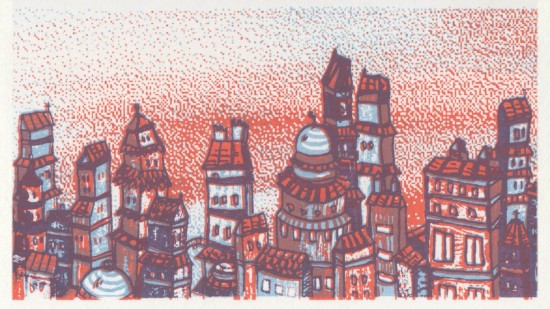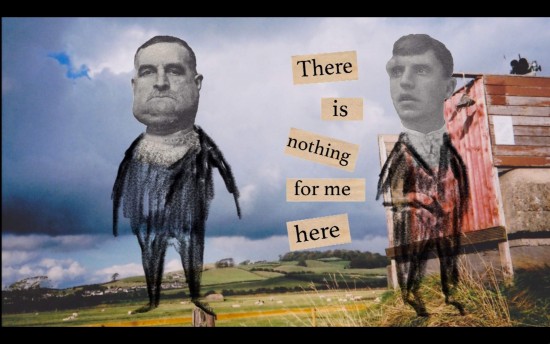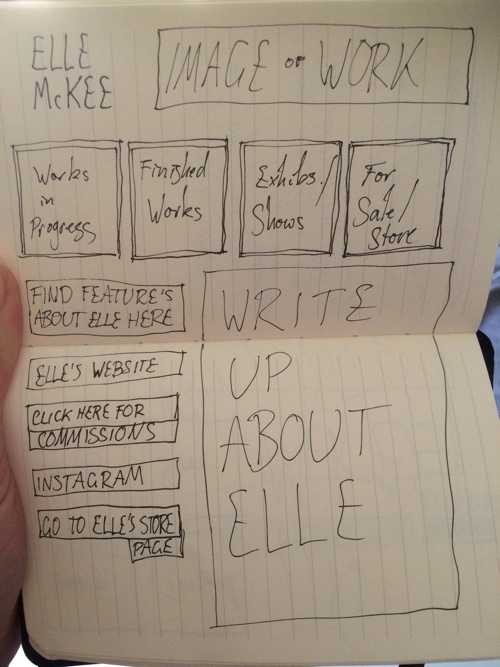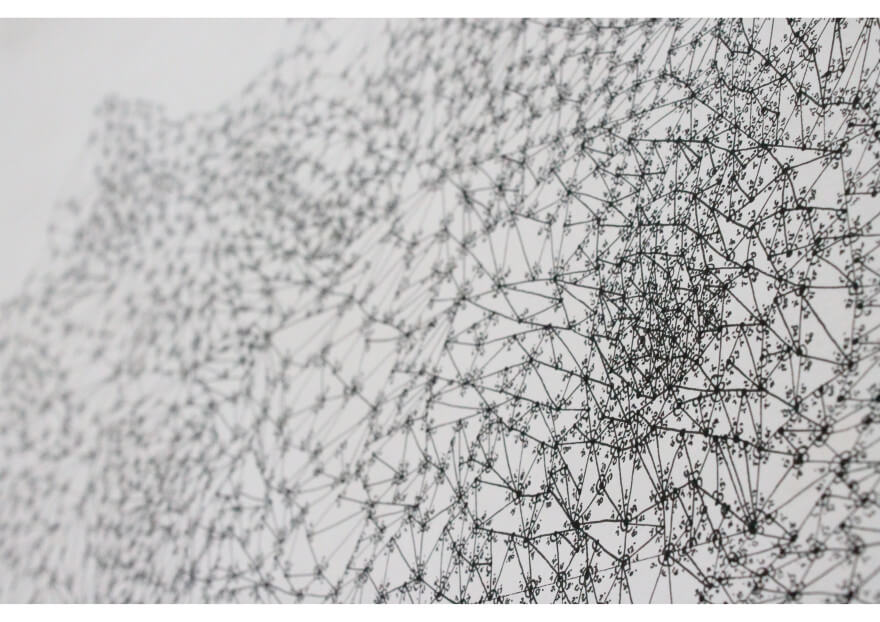Nica Harrison is currently in Gdansk working as one of the 100+ artists pulled together to create the world's first fully painted, animated feature film Loving Vincent. We can't wait to see it!
Below is an archived review of her solo film exhibition from May 2016.
Illusions was a solo exhibition curated by the artist/animator Nica Harrison. It also served as a preview for her film that was selected for Desert Dust Animation Festival, and Edinburgh International Film Festival. It was a relatively intimate occasion, as it only came about through a last minute idea of Nica’s to exhibit her production process as opposed to just screening the finished film.
Walking through the inners of the Edinburgh College of Art Main Building, one notices the spaces change. Initially a building of grandeur, stone pillars, housing a great exhibition hall and peppered with Classical sculptures, quickly becomes paint-aged floors and bins overflowing with discarded intentions. Anyone wanting to experience this exhibition first must walk through the areas intended for the a-typical displays of work, and become absorbed by the labyrinth of artists’ studios.
This already instils the feeling that one is seeing the side of creativity often forgotten about when viewing a film; you may have to walk up sweat inducing steps before even putting an idea on paper. You can be beading before your mind can wander. There is a physical process behind every creative one.
The painting studio Nica had chosen was at the top of such a perspiring spiral, and after doggedly falling through the door due to my despondent limbs, I fell into a world of calm.
No corner was left a shadow as rare Scottish sun cut through the glass roof, allowing hundreds of screen prints to be inspected with brutal clarity. I spent a period of time stood with my back barely a step from the door I had just come through, as the room before me was almost overwhelming. Nica had told people prior to the exhibition that her main intention was to showcase the method with which she had produced her film, the laborious arm workout they call screen printing. Not normally chosen for animation due to the amount of time needed to align frames, fret over colours and tones and the general physical labour, screen printing is a process that is worth showcasing.
Gazing around the room at the calming swathes of purple, blue, yellow, must be close to what it would feel like to be inside a zoetrope. The frames lined the wall in chronological order, with each column being a sequence. Logical chronology is not something often found within exhibitions, but again this reinforces the artist’s want for the animation process to be accessible to the audience.
In the centre of the room was a media megalith, business cards, a poster titling the exhibition and a television screen showing a montage of fixed-camera footage of Nica’s production process. This hub is yet another nod towards Nica’s want for the audience to have ease of accessibility.
After taking this all in, I went looking for some refreshments, being handed a beer out of a slightly leaking homemade ice-box. This reminds you that you are in a studio, you are amongst work that has been a struggle to put together. You can see certain frames coloured wrong, or offset, or with some colours not even registering. This isn’t a bad thing. This is a hard-work thing. The finished product we, the audience, normally see with animation is the clean, finished, edited film. This exhibition, leaky ice-box and all, is a testament to the sheer graft that the artist has put into the final film.
The aforementioned film was being screened a couple of hours after the studio opened for the exhibition, GOATS EYES was the tale Nica had adapted for her short film. The film is inspired by the short story Goat’s Eyes by Max Frei. It follows two characters whose stories become interconnected following an accident, due to which they find themselves lost, each in their own limbo. We follow them on their journey through the landscapes of their own imagination.
To get out they need to win a simple game with only one rule: The next level is just one step down.
As people walk around the studio, attempting to put the film together from the frames on the wall, the anticipation in the room gathers a humidity, so as the time for the screening comes, there is no dawdling as people quickly settled in front of the screen. Nica humbly introduced the film in a short impromptu preamble, and silence falls over the room as the film begins.
Having already been privy to the organic creation of the film, there is instant audience assimilation. The slight misalignment of many of the frames gives the film a sense of warmth, as it seems less like a generic polished piece, and more like a personal creation. The softness of the colour pallet used is matched well with the choice of voice actor Kenny Blyth, a softly spoken Scottish man, who subtly captures the confused feelings held by the male protagonist. As the film continues, the relatively abstract scenes start to pull together. This is when the film goes from comfortable to decidedly un-so. The barren soundstage - created by Tom Angell - with inclusion of only certain sounds, becomes unsettling. You begin to feel the sense of nothingness and uncertainty mirrored by the character.
The colours then change slightly upon the introduction of the female counterpart, voiced by Amandine Vincent. I think it must be stressed that in no way does the gender really have to be male and female, this is not some nuclear cis-gendered romance flick. In fact, gender itself isn’t alluded to, only the voices and the unassuming genitals give the viewer the idea of the sex of the characters. The second character goes through a parallel journey, but having experienced this before with the first character you met, this journey is one that you have a context for.
It is around this point when I realised the motif running through the composure of each frame; a goats eye. Be it the almond shape of an eye, or just a shape symbolising a pupil or iris, every frame can be seen as looking through, or in the reflection of, a goats eye.
As I looked around the room I saw my own enrapture, with a heavy dose of unsettledness, mirrored by my fellow audience members. I was also the only one looking anywhere other than the screen. It is telling of the strength in which this film pulls on the mind of the viewer, that even in this superfluously lit room with the intention of providing an artist as much natural light as possible, a large group of people can be put into a collective sense of unease.
As this film is yet to be screened at multiple festivals, I shall cease my recollection of the events of the film, as any further could ruin the journey through the piece. What I will recount are the elongated moments following the film’s credits, where breathing was not even breaking the silence. The rapturous applause did however. Once the whoops and whistles had subsided, and the creator had given a characteristically underplayed thank-you, discussion tore throughout the room. It is a film you need to talk about. I could pick from a myriad of overheard comments, but again, I do not wish to relieve anyone of the anticipation I had going into this screening. One request I heard made unto Nica sums up the seriousness in which
appreciation was held; a lecturer at the world leading California Institute of the Arts begged, ‘I need a copy of your film to show my students this summer’. Before any official screenings, this film has already affected someone from a very discerning establishment, to the point where they want this to influence the next generation of artists.
The overall experience was one of many levels, the interest one would get at a museum while understanding the process of creating something that a layman could not normally fathom, the feeling of being allowed to see a part of an artists world that is normally hidden away, the turbulence of watching the film itself, and the charge within the room as people unload what they have just seen onto each other. But the feeling that stays with you as you find your way out of the turns of studios and steps, is a bizarre one. You’re haunted, educated, but the strongest of the mix is the feeling that you have just managed to be one of the few that experienced something truly great before the rest of the world.
Illusions was an entirely unique experience, and with it leaves the illusion that Nica Harrison is someone still figuring things out. Nica Harrison is someone the world is about to be moved by.
Featured Artist






Related Articles

The Making of Dock: Code and Art
dockblog
TLDR; We have finally launched Dock and would love your feedback on the site: dockarts.com/feedback, thank you! Humble beginnings So this is a little different to the posts that…

Interview with Elle Mckee
interview
So what have you been working on recently? Well, after I finished my degree work for 3rd year, I was looking for competitions and briefs that are out in the real world. I looked into Glastonbury Festival’s ‘Don’t Pee’ Campaign